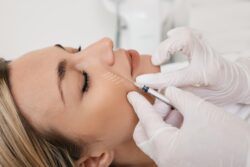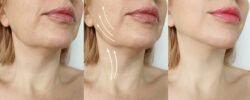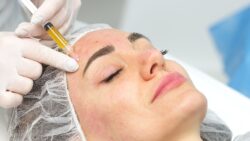
Do Dermal Fillers Ruin Your Face? Here’s What You Need to Know
Dermal fillers are more popular than ever, offering a simple, non-surgical way to enhance your features, restore lost volume, and smooth out wrinkles. Whether it’s adding a little fullness to your lips or defining your jawline, fillers can give you plenty of options to refresh your look.
That said, there are still some concerns and misunderstandings about them. One of the biggest fears is that fillers might “ruin” your face, making you look unnatural or overdone. Social media and extreme images don’t help, often making people hesitant to try fillers even though they can have amazing results.
So, do fillers actually ruin your face? In this blog, we’ll break down the facts, explain how fillers work, and share tips to make sure you get natural, beautiful results. If you’ve ever wondered about the impact of fillers, this guide is here to give you honest answers and clear advice.

What Are Dermal Fillers?
Dermal fillers are a type of treatment that involves injecting a substance into the skin to restore volume and smooth out wrinkles or fine lines. They’re commonly used to make areas of the face look fuller and more youthful, especially as we age or lose weight. The most popular fillers are made from hyaluronic acid, a substance that’s naturally found in the body and helps keep the skin plump and hydrated. Some fillers, like collagen stimulators, help your skin produce more collagen, offering longer-lasting effects.
Common Uses of Dermal Fillers
Dermal fillers are used for a variety of reasons, including:
- Restoring Volume: As we get older, our face can lose fat, causing areas like the cheeks to appear hollow or sunken. Fillers add volume back to those areas, giving the face a fuller, more youthful look.
- Smoothing Wrinkles: Fillers can help soften fine lines and wrinkles around the mouth, eyes, and forehead, making the skin look smoother and fresher.
- Contouring Features: Fillers are often used to enhance facial features like the jawline, chin, or nose, or to add volume to the lips and cheeks, helping to create a more balanced appearance.
How Do Dermal Fillers Work?
Dermal fillers are injected directly into areas where extra volume or smoothing is needed. The filler material adds volume under the skin’s surface, which helps smooth out lines or plump up the skin.
For instance, hyaluronic acid-based fillers attract moisture and bind it to the skin, restoring lost volume. Other types of fillers, like collagen stimulators, encourage the body to produce more collagen, which helps keep the skin firm and youthful over time.
The goal with dermal fillers is to enhance your natural look, giving you a refreshed and youthful appearance without making drastic changes. While the results aren’t permanent, they typically last anywhere from six months to two years, depending on the filler type and where it’s used.
Do Fillers Ruin Your Face?
It’s a worry that a lot of people share, and it makes sense. When you change your appearance, there’s always a bit of concern about looking unnatural or overdone. The truth is, when done right, dermal fillers won’t ruin your face. They can actually enhance your natural features and help you look refreshed and youthful. But like any cosmetic treatment, there are some risks to be aware of.
What Are the Risks?
Most people who get dermal fillers are happy with their results, but it’s still important to know about the possible risks. Here are some of the things to consider:
‘Pillow Face’
This describes a puffy, over-inflated look that can happen if too much filler is used or if it’s placed in the wrong spots. A good practitioner will make sure to use just the right amount and place it carefully so you don’t end up with this unnatural look.
Vascular Occlusion
This is a rare but serious complication where the filler gets into a blood vessel and blocks blood flow. If it’s not treated right away, it can lead to tissue damage or scarring. This is why it’s so important to choose a skilled and experienced professional for your treatment.
‘Duck Lips’
This happens when lip fillers create an exaggerated, over-plumped look. It’s usually the result of too much filler or uneven application. When done properly, lip fillers should look natural and enhance your lips, not make them look overly big or awkward.
Swelling and Bruising
Swelling and bruising are pretty normal after getting dermal fillers because the injections can irritate the skin and tissues. Most of the time, these go away within a few days to a week. Your provider can suggest ways to minimize swelling, like using cold compresses or avoiding strenuous activities after the treatment.
Uneven Distribution
Sometimes, if the filler isn’t applied evenly, it can cause lumps or uneven areas. In most cases, this can be fixed with some gentle massaging or adding more filler where needed. If needed, additional treatments can help smooth things out.
Allergic Reactions
Although rare, some people might have an allergic reaction to the filler. This can include redness, swelling, or itching at the injection site. Before getting dermal fillers, your provider will check for any allergies or conditions that could make the procedure less safe for you.
Overall, dermal fillers are safe and effective when done by a trained professional. If you choose someone with experience, you’ll get great results while minimizing the risks.
Tips for Safe and Natural Dermal Filler Results
If you’re considering dermal fillers, you want natural, safe, and effective results. When done right, fillers can enhance your features without looking overdone. Here’s what to keep in mind for the best outcome.

Choose the Right Professional
The first step to getting natural-looking results is choosing the right provider. Look for someone who is certified and has experience working with facial anatomy. The face is delicate and complex, so you need a professional who knows exactly where to place the filler to create a balanced, flattering look.
A good provider will understand the details of your face and use the right filler for different areas. They should be able to show you examples of their work, explain the process in detail, and make sure you feel comfortable throughout the procedure.
The Role of Moderation
When it comes to dermal fillers, moderation is key. A common mistake people make is trying to achieve dramatic results by overfilling. However, too much filler can lead to an unnatural, puffy look. For a more natural result, it’s better to use just the right amount to enhance your features without going overboard.
Experienced injectors know that using a small amount of filler can often create a more natural, youthful look than trying to add too much. The goal is to highlight your natural beauty, not completely change your face.
Tailored to Your Face
Everyone’s face is unique, so dermal filler treatments should be personalized. A skilled provider will look at your individual features, skin quality, and goals to decide exactly where and how much filler to use.
They’ll consider your age, skin type, and any areas where volume loss may have occurred. By taking all of this into account, they’ll be able to apply the filler in a way that’s balanced and perfectly suited to your features.
By choosing the right provider, using moderation, and customizing your treatment, you’ll get safe, natural-looking results that enhance your natural beauty.
The Truth About Dermal Fillers
Many people wonder if dermal fillers will permanently change their face. It’s a valid concern, but fillers are temporary, and they don’t leave permanent changes.
Do Fillers Permanently Change Your Face?
No, dermal fillers don’t permanently alter your face. They enhance your appearance, but the effects are temporary. Most fillers, like those made from hyaluronic acid, are absorbed by your body over time. After a while, your face will return to how it looked before, or show the natural signs of aging. Fillers generally last from six months to two years, after which your skin will go back to its original state.
How Fillers Break Down Over Time
Hyaluronic acid-based fillers naturally dissolve as your body absorbs them. Other fillers, like collagen stimulators, help your skin produce more collagen, leaving longer-lasting effects before breaking down.
What Happens in the Short and Long Term
Fillers can restore volume, smooth wrinkles, and define areas like the cheeks or jawline. These changes last from a few months to a couple of years. In the long term, fillers won’t permanently reshape your face, but collagen stimulators can help improve skin elasticity for longer.
What Happens If You Stop Using Fillers?
If you stop using fillers, your skin will gradually return to its natural state. Areas that were filled, like your cheeks or lips, may lose some fullness, but they won’t sag or look worse than before. Stopping fillers won’t make your skin age faster or cause it to sag more than usual. Your skin will continue aging at its normal pace.

When Fillers Might Not Be the Best Choice
Dermal fillers can be a great way to improve your look, but they aren’t the right fit for everyone or every situation. There are times when other treatments might be better for you, and it’s important to know when to explore those options.
When Fillers Are Misused
In some cases, dermal fillers don’t give the results people hope for, and this often comes down to misuse. Whether it’s too much filler, the wrong technique, or an inexperienced provider, here’s what can go wrong:
Overfilling: Using too much filler in one area can make things look unnatural or “puffy.” This tends to happen around the cheeks, under-eye area, or lips. The goal with fillers is enhancement, not a drastic change.
Inexperienced Providers: If the person doing the injections doesn’t have enough experience, they might place the filler wrong. This can cause uneven results, lumps, or even asymmetry. It’s so important to choose a skilled provider who knows facial anatomy well.
Wrong Filler Choices: Not all fillers are the same. Some are better suited for specific areas of the face. If the wrong filler is used in the wrong spot, it can look off. For example, a thick filler used where a lighter one is needed can lead to an unnatural appearance.
These issues are rare when working with an experienced professional, but they highlight how important it is to choose a skilled provider and to use the right technique.
Alternatives to Fillers
If you’re unsure whether fillers are right for you, or if you’d like to try something different, there are plenty of alternatives worth considering. Depending on your goals, treatments like Botox, laser therapy, or a solid skincare routine might be better for you.
Botox: While fillers add volume, Botox works by relaxing the muscles that cause wrinkles. It’s often used for crow’s feet, frown lines, and forehead wrinkles. Botox can give the face a softer, more youthful appearance without adding volume.
Laser Therapy: If you want to target skin texture, tone, or pigmentation issues, laser treatments can be a great option. Lasers can help stimulate collagen, improve skin elasticity, and reduce wrinkles. Plus, laser treatments are non-invasive and offer long-lasting results.
Skincare Routines: Sometimes, the best way to maintain youthful skin is through a solid skincare routine. Products with retinol, peptides, and antioxidants can help keep your skin smooth and healthy. Professional facials, chemical peels, and microneedling are also great alternatives if you’re looking for non-invasive options.
Signs of Bad Filler Work
Lumps and Bumps
One common sign that something went wrong is lumps or bumps under the skin. This happens when the filler is injected unevenly or too much is used. It can make the treated area look uneven or unnatural.
Asymmetry
If one side of your face looks different from the other after getting fillers, it could mean the filler wasn’t applied evenly. This can create a lopsided appearance. Fillers should highlight your natural features, not drastically change them, so any noticeable unevenness should be addressed.
Overfilled or “Pillow Face”
Using too much filler can make your face look swollen or overly full, especially in areas like the cheeks, lips, or under the eyes. Instead of adding a natural volume, you might end up looking puffy or “overdone.”
Discoloration or Bruising
Some bruising is normal after filler injections, but if there’s excessive bruising or strange discoloration around the treatment area, it could mean something went wrong. This might be due to poor technique, injecting too deeply, or even hitting a blood vessel.
Infections
While rare, infections can happen if the filler isn’t injected properly or aftercare instructions aren’t followed. If you notice redness, warmth, or pus at the injection site, reach out to your provider right away.
“Duck Lips” or Overdone Lips
If your lips look overly plump or have an unnatural shape after filler treatment, it might mean too much filler was used or it was injected incorrectly. Well-done lip fillers should look natural and balanced with the rest of your face, not exaggerated.
Being aware of these signs can help you make sure your filler treatment gives you the best possible outcome.

Tips for Making Informed Decisions About Dermal Fillers
Choosing dermal fillers is a personal decision, so it’s important to be well-informed before proceeding. With many options available, these tips can help you make the right choice for safe and natural-looking results.
Research Your Provider and Procedure
Before deciding on fillers, research your provider. Look for a licensed, certified professional with experience in injectable treatments and facial anatomy. Check reviews, ask for recommendations, and review before-and-after photos. Also, make sure you understand the procedure and what to expect. A good provider will gladly answer your questions.
Have a Consultation to Discuss Expectations
A consultation allows you to discuss your goals and any concerns. Your provider will assess your needs and suggest a plan that’s right for you. Make sure to talk about the realistic results you can expect. This helps set clear expectations and prevents disappointment.
Understand the Filler and Its Results
Different fillers have different purposes. Some add volume, others smooth wrinkles or boost collagen. Your provider should explain which filler will be used, how long it lasts, and the results to expect. It’s also helpful to know how the filler will break down over time.
Start Small and Adjust
If you’re new to fillers, start with a smaller amount. This allows you to assess the results before deciding to add more. Starting small reduces the risk of overfilling and gives your provider a chance to adjust for a more natural look. It also lets you see how your skin responds and make changes as needed.
Understanding Dermal Fillers
Dermal fillers are a popular option to enhance your appearance, smooth wrinkles, or add volume. When done by a skilled professional, they can give safe, natural results.
The key is choosing the right provider, understanding the procedure, and starting with a small amount to avoid drastic changes.
Your decision should be about what makes you feel confident. By doing your research and working with an experienced provider, you can enjoy the benefits of fillers with peace of mind. If you’re ready to explore your options with trusted professionals, schedule a consultation with Palm Beach Dermatology Group today!
FAQs
How long do dermal fillers last?
Dermal fillers typically last anywhere from 6 months to 2 years. It really depends on the type of filler used, where it’s applied, and how your skin reacts. For example, hyaluronic acid fillers usually last 6 to 12 months, while collagen stimulators can last up to 2 years or longer. Your provider will help you figure out what to expect based on your treatment.
Are dermal fillers painful?
Most people find the process pretty comfortable. Many fillers include a numbing agent, and your provider may apply a topical numbing cream before starting. You might feel a small pinch or some pressure, but it’s generally a quick and easy procedure, and any discomfort usually fades right away.
How soon will I see results?
You’ll notice changes right after the treatment, though you might see some swelling or bruising at first. The final results usually show up within a few days to a week after the swelling goes down.
Can dermal fillers be reversed?
In most cases, yes. If you’re not happy with the results or experience any issues, fillers made from hyaluronic acid can be dissolved with an injection that breaks down the filler. However, other types of fillers, like collagen stimulators, are more permanent and can’t be dissolved. It’s a good idea to discuss your options before the procedure.
Are there any risks or side effects?
Like with any treatment, there are a few risks. The most common side effects are swelling, bruising, and redness, but these usually go away after a few days. Rarely, more serious issues like infection or lumps can happen. Choosing an experienced provider helps minimize these risks and makes sure you’re safe.
Can fillers be combined with other treatments like Botox?
Yes. Many people combine fillers with Botox for a more complete facial rejuvenation. While Botox smooths out wrinkles caused by muscle movement, fillers restore volume and smooth out deeper lines. Combining both can give you a more refreshed and balanced look. Talk to your provider to see if this approach makes sense for you.
How soon can I return to normal activities after fillers?
Most people can get back to their usual routine right after getting fillers. That said, it’s a good idea to avoid any heavy exercise or anything that could make your face flush for 24 to 48 hours. You should also stay out of the sun and avoid touching the treated areas. Swelling and bruising are common but typically go away in just a few days.
Are fillers suitable for everyone?
Fillers are safe for most people, but they might not be the best option for everyone. If you’re pregnant, breastfeeding, or have certain skin conditions or allergies, your provider might suggest skipping fillers. Make sure to have a detailed consultation to see if they’re right for you.
How do I choose the right filler for my needs?
There are different fillers for different goals. For example, hyaluronic acid fillers are great for smoothing out wrinkles and adding volume to areas like your cheeks or lips, while collagen stimulators work for long-term volume restoration. Your provider will assess your face and help you choose the best option based on what you want to achieve.
What if I don’t like the results?
If you’re not happy with how it turned out, don’t worry. Most hyaluronic acid fillers can be adjusted or dissolved to fix any issues. It’s important to communicate with your provider after the treatment if you have any concerns. They’ll work with you to make sure you’re happy with the final look.
